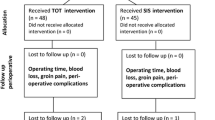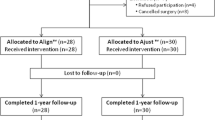Abstract
Introduction and hypothesis
We tested the hypothesis that the single-incision sling, TVT-Secur (TVT-S), placed in U position is not inferior to transobturator midurethral sling (TVT-O) for treating stress urinary incontinence (SUI).
Methods
This was a noninferiority, prospective, randomized controlled trial in which women with SUI, confirmed by physical and urodynamic evaluation, were randomly assigned to receive either TVT-O (n = 56) or TVT-S (n = 66). Exclusion criteria were voiding dysfunction, detrusor overactivity (DO), and pelvic organ prolapse (POP) beyond the hymen. The primary outcomes were objective and subjective cure rates, which were assessed at the 12-month follow-up visit, defined as negative stress, pad, and urodynamic tests and absence of self-reported SUI symptoms. Secondary outcomes were quality of life (QoL) by King’s Health Questionnaire (KHQ) validated for Portuguese language, postoperative pain, and complication rate. The power of the study was 80 % to test the hypothesis that TVT-S is not inferior to TVT-O by >15 %. Statistical significance was fixed at 5 % (p < 0.05).
Results
Groups were similar regarding demographic and clinical preoperative parameters. Objective cure rates for TVT-S and TVT-O groups were 84.1 % vs 87 % [90 % confidence interbal (CI) −15 to 9.8], and subjective cure rates were 92.1 % vs 90.7 % (95 % CI −11.4 to 6.7), respectively. TVT-S resulted in less postoperative general and thigh pain (p < 0.001). A few, but not statistically significant different complications, were observed in both groups: vaginal mucosa perforation, urinary retention, urinary infection, tape exposure, and de novo urgency. There was a significant improvement in all KHQ domains in both groups (p < 0.001).
Conclusion
TVT-S was not inferior to TVT-O for treating SUI at 12-month follow-up.



Similar content being viewed by others
References
Fong ED, Nitti VW (2010) Review article: mid-urethral synthetic slings for female stress urinary incontinence. BJU Int 106(5):596–608
Ogah J, Cody DJ, Rogerson L (2011) Minimally invasive synthetic suburethral sling operations for stress urinary incontinence in women: a short version cochrane review. Neurourol Urodyn 30:284–291
Neumam M (2007) TVT-obturator: short-term data on an operative procedure for the cure of female stress urinary incontinence performed on 300 patients. Eur Urol 51:1083–1087
Neuman M (2008) Perioperative complications and early follow-pu with 100 TVT-SECUR procederes. J Minim Invasive Gynecol 15:480–484
Debodiance P, Lagrange E, Amblard J, Lenoble C, Lucot JP, Villet R, Jacquetin B (2008) TVT secur: more and more minimal invasive. Preliminary prospective study on 110 cases. J Gynecol Obstet Biol Reprod 37:229–236
Sola V, Ricci P, Pardo J (2009) Third generation sub-mid uretral mesh:expirience with 110 TVT-S. Arch Esp Urol 62(5):376–388
Tommaselli GA, Di Carlo C, Gargano V, Formisano C, Scala M, Nappi C (2010) Efficacy and safety of TVT-O and TVT-Secur in treatment of female stress urinary incontinence: 1-year follow-up. Int Urogynecol J 21(10):1211–1217
Hinoul P, Vervest H, Boon J, Venema P (2011) A randomized, controlled trial comparing an innovative single-incision sling with an established transobturator sling to treat female stress urinary incontinence. J Urol 185:1356–1362
Wang Y, Li F, Wang Q, Yang S, Cai X, Chen Y (2011) Comparison of three mid-urethral tension-free tapes (TVT, TVT-O, and TVT-Secur) in the treatment of female stress urinary incontinence: 1-year follow-up. Int Urogynecol J 22:1369–1374
Cornu JN, Sèbe P, Peyrat L, Ciofu C, Cussenot O, Haab F (2010) Misterm prospective evaluation of TVT-Secur reveals high failure rate. Eur Urol 58:157–161
Hahn I, Fall M (1991) Objective quantification of stress urinary incontinence: a short reproducible, provocative pad-test. Neurourol Urodyn 10:475–481
Fonseca ESM, Camargo ALM, Castro RA, Sartori MGF, Fonseca MCM, Lima GR, Girão MJBC (2005) Validação do questiomário de qualidade de vida (King’s Health Questionnarie) em mulheres brasileiras com incontinência urinária. Rev Bras Ginecol Obstet 27:235–242
de Leval J (2003) Novel surgical technique for treatment of the female stress urinary incontinence: transobturator vaginal tape inside-out. Eur Urol 44:724–730
Lee KS, Lee YS, Seo JT, Na YG, Choo MS, Kim JC, Seo JH, Yoon JM, Lee JG, Kim DY, Yoo ES, Min KS, Hong JY, Lee JZ (2010) A prospective multicenter randomized comparative study between the U- and H-type methods of the TVT SECUR procedure for the treatment of female stress urinary incontinence: 1-year follow-up. Eur Urol 57:973–979
Staat M, Trenz E, Lohmann P, Frotscher R, Klinge U, Tabaza R, Kirschner-Hermanns R (2012) New measurements to compare soft tissue anchoring systems in pelvic floor surgery. J Biomed Mater Res B Appl Biomater 100(4):924–933
Kim JJ, Lee YS, Lee KS (2010) Randomized comparative study of the U- and H-type approaches of the TVT-secur procedure for the treatment of female stress urinary incontinence: one-year follow-up. Korean J Urol 51:250–256
Oliveira R, Silva C, Dinis P, Cruz F (2011) Suburethral single incision slings in the treatment of female stress urinary incontinence. What is the evidence for using them in 2010? Arch Esp Urol 64(4):339–346
Bernasconi F, Napolitano V, Natale F, Leone V, Lijoi D, Cervigni M (2012) TVT SECUR System: final results of a prospective, observational, multicentric study. Int Urogynecol J 23(1):93–98
Walsh CA (2011) TVT-Secur mini-sling for stress urinary incontinence: a review of outcomes at 12 months. BJU Int 108:652–657
Larsson PG, Teleman P, Persson J (2010) A serious bleeding complication with injury of the corona mortis with the TVT-Secur procedure. Int Urogynecol J Pelvic Floor Dysfunct 21:1175–1177
Masata J, Martan A, Svabik K (2008) Severe bleeding from internal obturator muscle following tension-free tape Secur hammock approach procedure. Int Urogynecol J 19:1581–1583
Araco F, Gravante G, Sesti F, Piccione E (2009) Tension-free vaginal tape Secur hammock procedure: two additional cases of intraoperative bleeding. Int Urogynecol J 20:125
Palva K, Nilsson CG (2011) Prevalence of urinary urgency symptoms decreases by mid-urethral sling procedures for treatment of stress incontinence. Int Urogynecol J 22:1241–1247
Barber MD, Weidner AC, Sokol AI, Amundsen CL, Jelovsek JE, Karram MM, Ellerkmann M, Rardin CR, Iglesia CB, Toglia M (2012) Single-incision mini-sling compared with tension-free vaginal tape for the treatment of stress urinary incontinence. A randomized controlled trial. Obstet Gynecol 119(2, Part 1):328–337
Abdel-Fattah M, Ford JA, Lim CP, Madhuvrata P (2011) Single-incision mini-slings versus standard midurethral slings in surgical management of female stress urinary incontinence: a meta-analysis of effectiveness and complications. Eur Urol 60:468–480
Collins SL, Andrew-Moore R, MacQuay HJ (1997) The visual analog pain intensity scale: what is moderate pain in millimeters? Pain 72:95–97
Latthe PM, Singh P, Foon R, Toozs-Hobson P (2010) Two routes of transobturator tape procedures in stress urinary incontinence: a meta-analysis with direct and indirect comparison of randomized trials. BJU Int 106:68–76
Conflicts of interest
None
Author information
Authors and Affiliations
Corresponding author
Additional information
Registration: Clinical Trials.gov Protocol Registration System, http://www.clinicaltrials.gov, NCT 01095159, TVTO™ X TVTS ™ for Treatment of Stress Urinary Incontinence
Funded by Federal University of São Paulo
Rights and permissions
About this article
Cite this article
Bianchi-Ferraro, A.M.H.M., Jarmy-Di Bella, Z.I.K., Castro, R.d.A. et al. Single-incision sling compared with transobturator sling for treating stress urinary incontinence: a randomized controlled trial. Int Urogynecol J 24, 1459–1465 (2013). https://doi.org/10.1007/s00192-012-1998-2
Received:
Accepted:
Published:
Issue Date:
DOI: https://doi.org/10.1007/s00192-012-1998-2




